View in other NatureServe Network Field Guides
NatureServe
Montana
Utah
Wyoming
Idaho
Wisconsin
British Columbia
South Carolina
Yukon
California
New York
Roundleaf Sundew - Drosera rotundifolia
State Rank Reason (see State Rank above)
Our most common sundew. Numerous occurrences in fens across western Montana.
- Details on Status Ranking and Review
Population Size
Score0-1 - Moderate to Large: Population size is imprecisely known but is believed to be >10,000 individuals.
CommentPopulation sizes are generally undocumented. However, it is generally more abundant than Drosera anglica.
Range Extent
Score0 - Widespread species within Montana (occurs in 5% or more of the state or generally occurring in 6 or more sub-basins.) as well as outside of Montana.
Area of Occupancy
Score0-1 - Moderate to High. Occurs in >10 Subwatersheds (6th Code HUC’s), though the species' distribution is not sufficiently documented to place it within one class.
Environmental Specificity
Score2 - High: Species is restricted to a highly specialized and limited habitat and is typically dependent upon unaltered, high-quality habitat (C Values of 8-10).
Trends
ScoreNA - Rank factor not assessed.
Threats
Score1 - Medium: 11-30% of the populations are being negatively impacted or are likely to be impacted by one or more activities or agents, which are expected to result in decreased populations and/or habitat quality and/or quantity.
Intrinsic Vulnerability
Score1-2 - Moderate to High Vulnerability.
Raw Conservation Status Score
Score
4 to 7 total points scored out of a possible 16 (Rarity factors and threats only).
General Description
PLANTS: Perennial herbs with basal leaves and an unbranched, leafless stem that is 3-20 cm tall. Plants arise from a central rootcrown. Source: Lesica et al. 2012.
LEAVES: The leaves are spreading to prostrate, all basal and borne on petioles 1-3 cm long. They have roundish (orbicular) blades that are 4-12 mm long; just as wide as long. The upper surfaces are covered with reddish-purple, stalked glands that trap insects. Source: Lesica et al. 2012.
INFLORESCENCE: A 1-sided, nodding, 2 to 7 flowered, raceme-like cyme. Flowers are perfect and have 5 white petals. Source: Lesica et al. 2012.
The specific epithet rotundifolia is a combination of the Latin words ‘rotundus’ and ‘folium’ translating to “round” and “leaf” respectively. This refers to its leaves being as wide as they are long.
Drosera is derived from the Greek ‘drosos’ meaning “dewdrops”, referring to the dewdrop-like glands on the leaves (Giblin et al. [eds.] 2018).
Phenology
Flowering June through September (Painter et al. 2012).
Diagnostic Characteristics
Montana has 3
Drosera species. All species are insectivorous, perennial herbs that trap prey on their sticky, gland-tipped leaf hairs. The inflorescences of all species are 1-sided, nodding, raceme-like cymes that consist of regular, white flowers. A hand-lens or microscope is required to measure the seeds.
Note that small, young basal rosettes are not particularly reliable or helpful for species identification (Rice 2019).
Roundleaf Sundew -
Drosera rotundifolia, native, PSOC
*Size: Mature plants are 3-20 cm tall.
*Leaves: Blades are orbicular, spreading, and 4-12 mm long with a 1-3 cm long petiole.
*Capsules: 3-5 mm high.
*Seeds: Elongate and flat at the tip and about 1.5 mm long.
*Flowers: Mature flowers have petals that are about 6 mm long, a shorter calyx, and usually 3 styles.
*Anthers: White.
English Sundew -
Drosera anglica, native, SOC
*Size: Mature plants are 8-25 cm tall.
*Leaves: Blades are narrowly oblong, ascending, and 10-25 mm long with a 2-6 cm long petiole.
*Capsules: 3-6 mm high.
*Seeds: Pointed at the tip and 1-1.5 mm long.
*Flowers: Mature flowers have petals that are 4-8 mm long, a calyx that is 4-5 mm long, and 4 to 5 styles.
*Anthers: Yellow.
Slenderleaf Sundew -
Drosera linearis, native, SOC
*Size: Mature plants up to 15 cm tall.
*Leaves: Blades are linear, ascending, and 2-5 cm long.
*Capsules: 4-5 mm high.
*Seeds: Round at the tip and less than 1 mm long.
*Flowers: Mature flowers have petals that are 4-8 mm long, a calyx that is 4-5 mm long, and 4 to 5 styles.
*Anthers: Bright orange.
Species Range
Montana Range
Range Descriptions
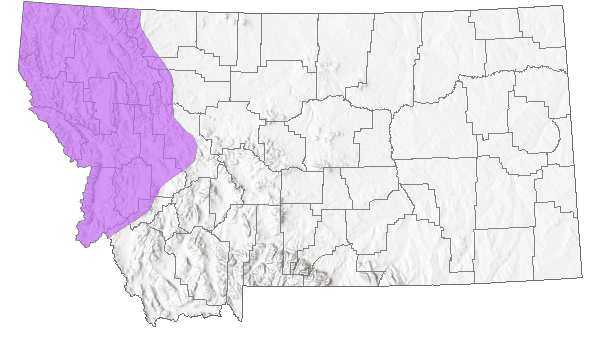
 Native
Native
Range Comments
Circumboreal with outlying populations in the Philippines and New Guinea (Rice 2019). In North America, south to CA, MY, ND and FL (Lesica et al. 2012).
Observations in Montana Natural Heritage Program Database
Number of Observations: 76
(Click on the following maps and charts to see full sized version)
Map Help and Descriptions
Relative Density
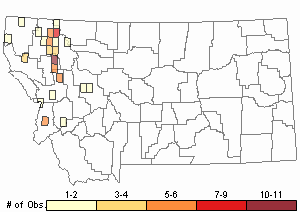
Recency
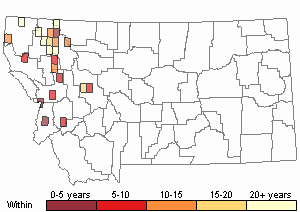
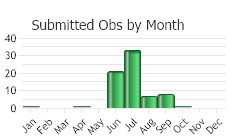
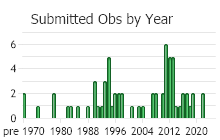
 (Observations spanning multiple months or years are excluded from time charts)
(Observations spanning multiple months or years are excluded from time charts)
Habitat
Roundleaf Sundew is found primarily in remote Sphagnum fens in the montane zone (Lesica et al. 2012).
National Vegetation Classification System Groups Associated with this Species
Wetland and Riparian
Peatland
Food Habits
Roundleaf Sundew traps and digests primarily insects from the Dipteran, Coleopteran, and Hymenopteran orders, but can trap many other arthropods (Wolf et al. 2006).
Ecology
HYBRIDIZATION
Drosera anglica most likely originated as a hybrid of D. linearis x D. rotundifolia (Wood 1955; Hoyo et al. 2015). Where their ranges overlap, D. anglica and D. rotundifolia may also hybridize to form the resulting hybrid Drosera x obovate (Wood 1955).
ASSOCIATED SPECIES
Roundleaf Sundew typically grows on floating mats covered with Sphagnum mosses. It is also closely associated with many Carex species including C. limosa and C. lasiocarpa and herbaceous dicots such as Menyanthes trifoliata and Comarum palustre (Wolf et al. 2006). When occurring in calcareous fens, it has been found with Dasiphora fruticosa and mosses including Campylium stellatum and Calliergonella species (Wolf et al. 2006).
PLANT COMPETITION
Since they are a shade intolerant species, Roundleaf Sundew must compete for sunlight (Wolf et al. 2006). Unlike other Drosera species, Roundleaf Sundew can produce a long axil form to overtop fast-growing Sphagnum (Wolf et al. 2006).
PREY CAPTURE
Prey insects are initially lured to plants by their brilliant red gland stalks (Wolf et al. 2006). This pigmentation may vary due to environmental effects such as sun exposure and inundation (Rice 2019). After landing or climbing onto the leaves, prey get stuck to the longer, trapping glands on the margins of the leaves which hold them in place while the shorter glands secrete digestive enzymes (Lloyd 1942). A bending of the leaf petiole to fold the leaf over itself also assists in keeping prey in place once entrapment has occurred (Darwin 1897).
HERBIVORY
Although it has not been observed on record in Montana, Moose on the Kenai Peninsula of Alaska commonly eat Roundleaf Sundew in early summer before flowering and also in early flowering stages (LeResche et al. 1974). While it is unlikely that there are invertebrates that specialize on the Drosera genus, Plume Moth caterpillars have been seen feeding on leaves of some species (Wolf et al. 2006).
FIRE ECOLOGY
Fire disturbance is necessary for maintaining the habitats that Roundleaf Sundew is found in because it removes invading woody plants (Matthews 1994). These woody species may block sunlight from reaching Roundleaf Sundew which is very shade intolerant. Where woody species have gone unchecked and grow densely, subsequent fires can be extreme enough to alter the plant communities of the fen.
Reproductive Characteristics
All three Drosera species can reproduce both sexually and vegetatively (Hoyo et al. 2015; Murza et al. 2003). Sexual reproduction is almost exclusively done through self-pollination leading to most offspring being genetically identical to parent plants whether they reproduce sexually or vegetatively (Wolf et al. 2006).
Roundleaf Sundew reproduces vegetatively by producing new raments that sprout from the stems (Hoyo et al. 2015). Axillary buds may also form below the rosette and then separate from the original plant when the stem decays (Matthews 1994).
FRUITS and SEEDS [Lesica et al. 2012; Giblin et al. [eds.] 2018]
Fruits are many-seeded capsules that are 4-5 mm long. Seeds are usually about 1.5 mm long, longitudinally striate, and prolonged and flattened at the tips.
FLOWERS
Each flower has 5 separate, white petals that are about 6 mm long and just longer than the calyx. There are 5 stamens and 3 styles, which are 2-lobed near the base (Lesica et al. 2012). The flowers of <Roundleaf Sundew are self-pollinating and therefore, almost never found open (Wolf et al. 2006).
LIFE CYCLE [Wolf et al. 2006]
Roundleaf Sundew can live up to 5 years. It has four main life stages including seed, seedling, mature plant and vegetative propagule. During this time, it may also go through two dormant life stages: seed bank and overwintering buds. First year seedlings do not reproduce.
Management
The most effective way to preserve populations of Drosera rotundifolia is to ensure that the water regimes of its primary habitat remain unaltered (Wolf et al. 2006). Better informed management decisions of D. rotundifolia populations can be made by taking inventory of watersheds where colonized fens are present. Activities such as logging, groundwater pumping, grazing, and recreation should be closely monitored for their effects on nutrient levels.
Stewardship Responsibility
Threats or Limiting Factors
The primary threat to Roundleaf Sundew is hydrologic alterations to the fens in which it lives (Wolf et al. 2006). Drosera species require very specific ground water conditions for plants to maintain their ideal nutrient levels. Being adapted to nutrient poor environments makes them extremely sensitive to nutrient level increases. When this is disrupted in any way, proper ecosystem functioning may be inhibited.
STATE THREAT SCORE REASON
Reported threats to Montana's populations of Roundleaf Sundew are currently assigned as unknown (MTNHP Threat Assessment 2021). Information of threats having impacts to known populations is needed.
References
- Literature Cited AboveLegend:
 View Online Publication
View Online Publication Lesica, P., M.T. Lavin, and P.F. Stickney. 2012. Manual of Montana Vascular Plants. Fort Worth, TX: BRIT Press. viii + 771 p.
Lesica, P., M.T. Lavin, and P.F. Stickney. 2012. Manual of Montana Vascular Plants. Fort Worth, TX: BRIT Press. viii + 771 p. MTNHP Threat Assessment. 2021. State Threat Score Assignment and Assessment of Reported Threats from 2006 to 2021 for State-listed Vascular Plants. Botany Program, Montana Natural Heritage Program, Helena, Montana.
MTNHP Threat Assessment. 2021. State Threat Score Assignment and Assessment of Reported Threats from 2006 to 2021 for State-listed Vascular Plants. Botany Program, Montana Natural Heritage Program, Helena, Montana.
- Additional ReferencesLegend:
 View Online Publication
View Online Publication
Do you know of a citation we're missing? Lesica, P., M.T. Lavin, and P.F. Stickney. 2022. Manual of Montana Vascular Plants, Second Edition. Fort Worth, TX: BRIT Press. viii + 779 p.
Lesica, P., M.T. Lavin, and P.F. Stickney. 2022. Manual of Montana Vascular Plants, Second Edition. Fort Worth, TX: BRIT Press. viii + 779 p. Rice, Barry A. 2019. The Genus Drosera L. (Droseraceae) in the western USA. March 21. Phytologia 101(1).
Rice, Barry A. 2019. The Genus Drosera L. (Droseraceae) in the western USA. March 21. Phytologia 101(1).
- Web Search Engines for Articles on "Roundleaf Sundew"





